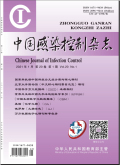中国感染控制杂志2024,Vol.23Issue(4):522-526,5.DOI:10.12138/j.issn.1671-9638.20245347
HIV感染者/AIDS患者衰弱状况及影响因素分析
Frailty status and influencing factors in people living with human immuno-deficiency virus infection/acquired immunodeficiency syndrome
摘要
Abstract
Objective To investigate the frailty status and influencing factors in people living with human immuno-deficiency virus(HIV)infection/acquired immunodeficiency syndrome(AIDS)(PLWHA).Methods PLWHA aged ≥18 years in a hospital in Changsha City from June to August 2019 were selected as the study subjects.The basic condition and frailty of the subjects were evaluated by self-designed questionnaire and Tilburg frailty indicator,respectively.Results The incidence of frailty in PLWHA was 26.4%,logistic regression analysis showed that patients with infection years>5 years had a 2.33 times higher risk of frailty compared with patients with infection years ≤5 years(95%CI:1.24-4.37,P=0.009).The risk of frailty in patients with a highest HIV load of≥100 000 copies/mL was 1.40 times higher than in patients with a highest HIV load of<100 000 copies/mL(95%CI:1.05-1.85,P=0.022).The risk of frailty in patients with CD4+T lymphocyte count<200 mm3 was 3.60 times higher than that in patients with CD4+T lymphocyte count ≥200 mm3(95%CI:1.96-6.62,P<0.001).Conclusion PLWHA with longer duration of HIV infection,lower CD4+ T lymphocyte count and higher HIV load are more prone to develop frailty.关键词
HIV感染者/AIDS患者/衰弱/影响因素/PLWHAKey words
people living with HIV/AIDS/frailty/influencing factor/PLWHA分类
预防医学引用本文复制引用
叶纤,鲁秋玲,胡佩武,陈丹,李杏莉..HIV感染者/AIDS患者衰弱状况及影响因素分析[J].中国感染控制杂志,2024,23(4):522-526,5.基金项目
湖南省自然科学基金项目(2022JJ30779) (2022JJ30779)

